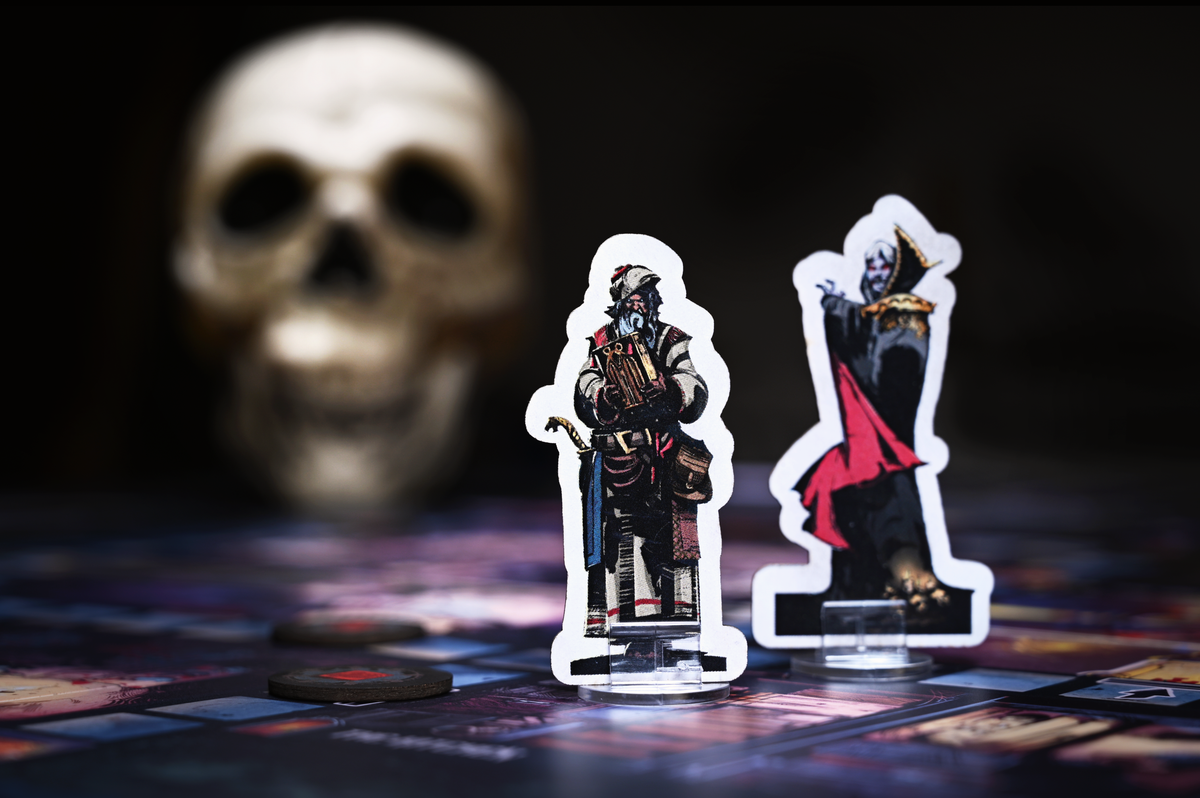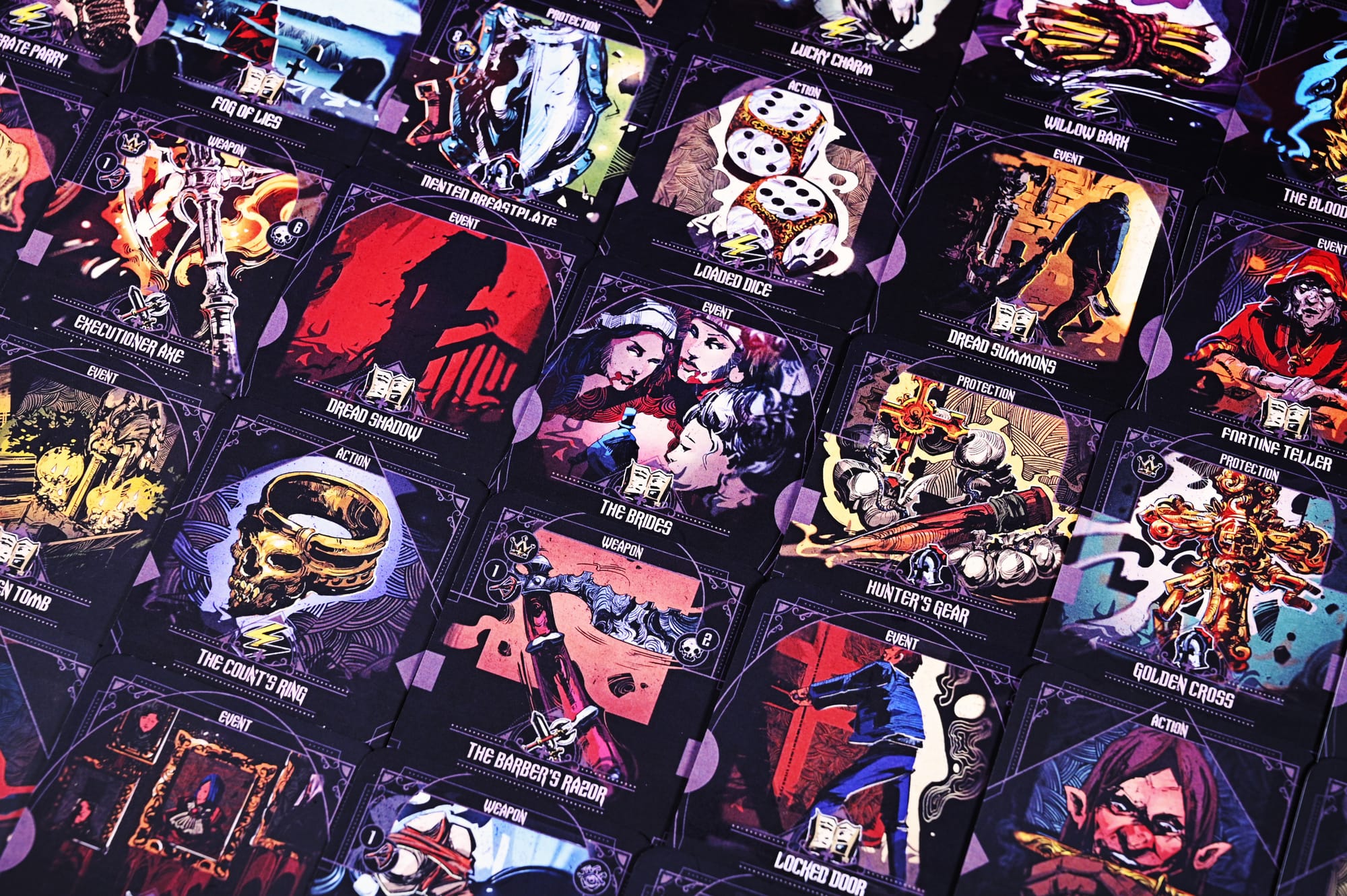
The Gothic Game, first released in a tiny quantity in 1992, is one of board gaming’s bona fide cult classics. It is from a time before designers and players insisted on Perfect Unfailing Balance and Fairness and other fun-murdering standards. It was a brutal, vindictive, and dreadfully silly game in absolute bad taste that sat somewhere between Talisman, Wiz-War, Mervyn Peake, and Hammer Horror. It was Designed by Robert Wynne-Simmons, probably best known as one of the screenwriters for the cult classic Blood on Satan’s Claw. My first game was in the mid-1990s. I was wearing a spiked dog collar and a Christian Death t-shirt.
I never owned a copy, but for a brief period circa 2005 or 2006 I worked on a slightly updated version of the gam. This was pre-crowdfunding, but I had a rich friend willing to bank-roll it, though as it happened we only got as far as having an email conversation with Mr. Wynne-Simmons. Anyway, I was pretty stoked when Blackletter Games launched a Kickstarter campaign for it, retitled: Damnation: The Gothic Game, so I contacted Kris Rees, the credited designer, and offered some thoughts about a remake. He sent me an early prototype and I was impressed with the direction of the game.
That initial Kickstarter failed. Not surprising, as The Gothic Game simply is not the kind of design that modern gamers are looking for. It is willfully, defiantly atavistic. Some of my fondest memories of playing it were with Eurogame crews who quite literally could not comprehend the fun of a roll-and-move player elimination game where the concept is that you are trying to gruesomely murder each other, with random instant death cards and wild swings of luck sometimes chained together in a ridiculous sequence of events. Despite the initial setback, a second campaign funded and now Damnation: The Gothic Game is stuck in the world like a dagger in the back, complete with some modernisation that I have very mixed feelings about.

At first glance Hue Teo’s very Mike Mignola-influenced illustrations are great. It’s a highly stylized look, yet I miss the original game’s stark box art and the crude pen-and-ink style of cards. But frankly, no game that has a board and cards that look like the original game has a chance in hell in today’s marketplace. Nonetheless it’s a handsome, modern production that’s suitably grim and severe, snd I applaud the use of 2D standees rather than loathsome miniatures.
The gameplay is largely intact. The box describes it as a “gothic horror battle royale”, a perfect summary. Players are assorted villains (now with special powers and so forth, as modern audiences expect) that are stuck in Count Dracula’s castle. It’s a dungeoncrawl where you wander around rooms, find item or encounter event cards, and try to do in everybody else before they do you in. You can get turned into a Vampire in the Vault, die instantly in an Iron Maiden at the Torture Chamber, happen upon a Black Mass in the Courtyard, or eat Mystery Pie in the Kitchen. The ten rooms have quite small sets of cards, and as the rulebook suggests you’ll learn what is in each room the more you play. This is important, because you can sort of plan on what may happen before you enter a room.
It's roll and move with a limited track. But here’s the stroke of genius and thank Satan that Mr. Rees left this in: The Power of Adjacency. If you land next to someone else, you control their next movement. And since this is a game where there are on-board traps including a never-ending spiral staircase that you’ve got to roll sixes to get out of, being able to move someone into a precarious situation is a blast. You can also just meathook or flintlock the adjacent player, provided they don’t have a protection card that blocks the damage.
The original game was extremely simple- the previous two paragraphs were longer than the rules. Mr. Wynne-Simmons wasn’t drawing from his experience playing 1,000 other hobby games and trying to emulate them, and as such The Gothic Game almost seems like outsider art now. But Damnation: The Gothic Game is decidedly aiming to appeal to a modern hobby game market, for better or worse, and this is where my thoughts on the game get conflicted.

Mr. Rees has added much to the game - it is almost “inspired by” the original rather than a proper remake. There’s now a black die rolled with the movement die that depicts the lighting in the castle and which adds a little more atmosphere. Talent tokens are used to activate character-specific special abilities and Soul tokens are traded at the Dark Tower for special cards. Slain characters become Haunts, which keeps players involved in the game after elimination and even gives them a chance at resurrection. And when someone is killed, Deathknell cards are flipped over that add new, lethal rules to the game that accelerate it towards a conclusion.
All of this is fine. Some of it is really fun. Some of it muddies the game and makes it more complicated than it should be. The net result of the new material for me, writing as one of maybe 10 or 15 Gothic Game diehards out here, is that in making this game more appealing to modern audiences it has lost a little of its quaint, outsider charm.
I’m disappointed that some of my favorite cards aren’t in the game now, some of the really silly, ridiculous stuff like a live Rhino that chases you out of the Trophy Room. The original cards were extremely specific, some of the protections for example only worked against one weapon, which made for some great dramatic moments. It feels like the original’s knack for generating absurdity organically through play has been diminished in order to create a more consistent and less volatile game. And personally I do not like that players have a chance to resurrect, part of the thrill of the old game was that it was super high stakes, and even when you got eliminated it was fun to stick around and laugh at other player’s misfortunes.
Granted, the rules invite you to make up your own variants which may mean rolling back some changes for me. The best variant we ever came up with was that a tacky, pewter Grim Reaper figure was put on the board and if you touched it you died immediately. We also had a house rule that if you didn’t throw the dice with the little cup that came with the game, you died instantly too. Which led to all kinds of chicanery where you’d try to get someone to take the dice and roll them without the cup you had in your other hand. These things, to me, were more in the spirit of the original game than some of what is in Damnation. But I do like Blackletter’s take on the game as written, and can recommend it as a very fun, very rowdy, and very capricious game. Just be aware that it will likely go down like the Hindenburg with some groups while becoming an all-time favourite with others.
Game Design: Kris Rees
Art: Hue Teo
Published by Blackletter Games
This feature originally appeared in Wyrd Science Vol.1, Issue 6 (August '24)
